Santa Fe de la Vera Cruz | |
|---|---|
City | |
 Santa Fe, Argentina | |
.svg.png.webp) Coat of arms | |
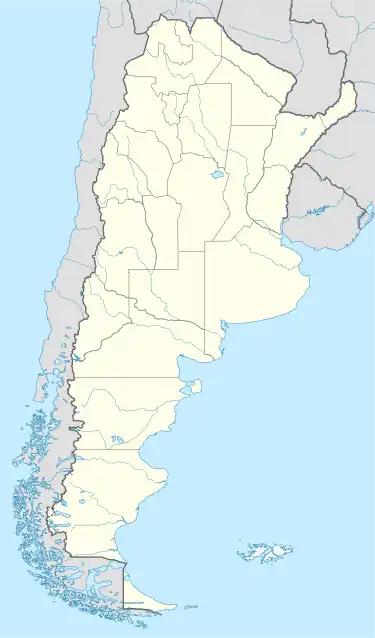 Santa Fe de la Vera Cruz Location of Santa Fe in Argentina 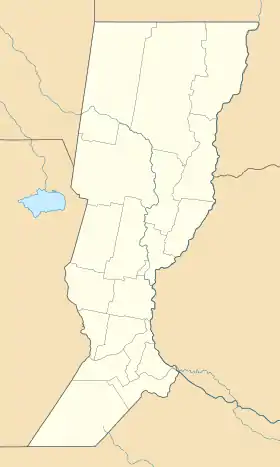 Santa Fe de la Vera Cruz Santa Fe de la Vera Cruz (Santa Fe Province) | |
| Coordinates: 31°38′S 60°42′W / 31.633°S 60.700°W | |
| Country | |
| Province | |
| Department | La Capital |
| Government | |
| • Mayor | Emilio Jatón (Partido Socialista) |
| Area | |
| • City | 748 km2 (289 sq mi) |
| Elevation | 25 m (82 ft) |
| Population (2010 census) | |
| • Urban | 391,164 |
| • Metro | 653,073 |
| Demonym | Santafesino/a |
| Time zone | UTC−3 (ART) |
| CPA base | S3000 |
| Dialing code | +54 342 |
| Website | santafeciudad.gov.ar |
Santa Fe de la Vera Cruz (Spanish pronunciation: [ˈsanta ˈfe ðe la ˈβeɾa ˈkɾus]; usually called just Santa Fe, lit. "Holy Faith") is the capital city of the province of Santa Fe, Argentina. It is situated in north-eastern Argentina, near the junction of the Paraná and Salado rivers. It lies 15 kilometres (9.3 mi) from the Hernandarias Subfluvial Tunnel that connects it to the city of Paraná. The city is also connected by canal with the port of Colastiné on the Paraná River. Santa Fe de la Vera Cruz has about 391,164 inhabitants per the 2010 census [INDEC]. The metropolitan area has a population of 653,073, making it the eighth largest in Argentina.
Santa Fe de la Vera Cruz is linked to Rosario (170 km (106 mi) to the south), the largest city in the province, by the Brigadier Estanislao López Highway and by National Route 11, which continues south towards Buenos Aires. Córdoba is about (340 km (211 mi) west of Santa Fe, through the National Route 19. Santa Fe is home to the Sauce Viejo Airport with daily direct flights to Rosario and Aeroparque Jorge Newbery in Buenos Aires.
History
Santa Fe de la Vera Cruz was founded on the nearby site of Cayastá in 1573 by the conquistador Juan de Garay (1528-1583)[1] during an expedition which he led from Asunción (in present-day Paraguay) to the Paraná River. (Cayastá today has a historical park containing the grave of Hernandarias (1561-1634), the first American-born governor in South America.) The settlement was moved to the present site in 1653 due to the constant flooding of the Cayastá River. The city of Santa Fe became the provincial capital in 1814, when the territory of the province of Santa Fe was separated from the province of Buenos Aires by the National Constituent Assembly, held in the city in 1853.
Santa Fe de la Vera Cruz became the commercial and transportation center for a rich agricultural area that produces grain, vegetable oils, and meats. The city is the site of the National Technological University – Santa Fe Regional Faculty, Catholic University of Santa Fe (inaugurated in 1959), and the National University of the Littoral (first founded as the Provincial University in 1889, it adopted its current name in 1919).
A suspension bridge was completed in 1924, though severe flooding partially destroyed it in 1983 (a second bridge, the Oroño, was opened in 1971). The city's location is still not immune to flooding. On April 29, 2003, the Salado, which empties into the Paraná near Santa Fe, rose almost 2 m (6.5 ft) in a few hours following heavy rainfall, and caused a catastrophic flood. No fewer than 100,000 people had to be evacuated, and large sections of the city remained under water more than a week later. That year, the suspension bridge was reopened, and in 2008, the city's historic grain silos were converted into the Los Silos Hotel and Casino, and San Martín Street was converted to pedestrian use.
The city's historical role in the Argentine Constitution led national lawmakers to choose it as the site of Constitutional Conventions in 1949, 1957, and 1994.
 Santa Fe rail station (1905), today the long-distance bus station
Santa Fe rail station (1905), today the long-distance bus station
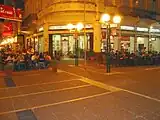 Pedestrian San Martín Street
Pedestrian San Martín Street
Climate
The city has a climate considered as humid subtropical (Cfa, according to the Köppen climate classification, with a Cwa tendency). Winters are generally mild, though minimum temperatures can fall below 0 °C (32.0 °F) on cold nights during the winter. Summers are generally hot and humid. During the most extreme heat waves, temperatures have exceeded 45 °C (113.0 °F). Temperatures have exceeded 35 °C (95.0 °F) in every season.[2]
Rainfall can be expected throughout the year though summer is usually the wettest season. Thunderstorms can be intense with frequent lightning, powerful downdraughts and intense precipitation. The lowest record temperature was −7.0 °C (19.4 °F) on June 13, 1967, while the highest recorded temperature was 45.6 °C (114.1 °F) on January 25, 1986.[3]
| Climate data for Santa Fe, SF (Sauce Viejo Airport) 1991–2020, extremes 1961–present | |||||||||||||
|---|---|---|---|---|---|---|---|---|---|---|---|---|---|
| Month | Jan | Feb | Mar | Apr | May | Jun | Jul | Aug | Sep | Oct | Nov | Dec | Year |
| Record high °C (°F) | 45.6 (114.1) |
40.9 (105.6) |
38.6 (101.5) |
36.5 (97.7) |
34.3 (93.7) |
30.9 (87.6) |
33.6 (92.5) |
38.6 (101.5) |
39.9 (103.8) |
41.0 (105.8) |
44.0 (111.2) |
42.9 (109.2) |
45.6 (114.1) |
| Mean daily maximum °C (°F) | 31.5 (88.7) |
30.0 (86.0) |
28.5 (83.3) |
24.6 (76.3) |
21.0 (69.8) |
18.0 (64.4) |
17.5 (63.5) |
20.3 (68.5) |
22.5 (72.5) |
25.2 (77.4) |
28.0 (82.4) |
30.2 (86.4) |
24.8 (76.6) |
| Daily mean °C (°F) | 25.7 (78.3) |
24.4 (75.9) |
22.6 (72.7) |
18.9 (66.0) |
15.5 (59.9) |
12.4 (54.3) |
11.5 (52.7) |
13.8 (56.8) |
16.3 (61.3) |
19.4 (66.9) |
22.2 (72.0) |
24.4 (75.9) |
18.9 (66.0) |
| Mean daily minimum °C (°F) | 20.1 (68.2) |
19.1 (66.4) |
17.6 (63.7) |
14.0 (57.2) |
11.0 (51.8) |
7.9 (46.2) |
6.7 (44.1) |
8.3 (46.9) |
10.6 (51.1) |
14.0 (57.2) |
16.5 (61.7) |
18.7 (65.7) |
13.7 (56.7) |
| Record low °C (°F) | 7.2 (45.0) |
6.2 (43.2) |
3.1 (37.6) |
0.2 (32.4) |
−5.0 (23.0) |
−7.0 (19.4) |
−6.6 (20.1) |
−5.0 (23.0) |
−2.9 (26.8) |
0.2 (32.4) |
3.9 (39.0) |
5.6 (42.1) |
−7.0 (19.4) |
| Average precipitation mm (inches) | 98.7 (3.89) |
117.5 (4.63) |
138.4 (5.45) |
127.9 (5.04) |
52.1 (2.05) |
33.3 (1.31) |
25.4 (1.00) |
32.2 (1.27) |
49.4 (1.94) |
114.8 (4.52) |
143.0 (5.63) |
143.1 (5.63) |
1,075.8 (42.35) |
| Average precipitation days (≥ 0.1 mm) | 7.0 | 7.3 | 7.1 | 8.0 | 5.0 | 3.5 | 3.2 | 3.5 | 5.4 | 7.9 | 7.7 | 8.3 | 73.9 |
| Average relative humidity (%) | 68.5 | 72.9 | 75.0 | 78.5 | 80.7 | 80.7 | 77.4 | 72.0 | 69.1 | 70.2 | 67.4 | 67.2 | 73.3 |
| Mean monthly sunshine hours | 288.3 | 240.1 | 241.8 | 195.0 | 176.7 | 150.0 | 179.8 | 210.8 | 210.0 | 235.6 | 267.0 | 266.6 | 2,661.7 |
| Mean daily sunshine hours | 9.3 | 8.5 | 7.8 | 6.5 | 5.7 | 5.0 | 5.8 | 6.8 | 7.0 | 7.6 | 8.9 | 8.6 | 7.3 |
| Percent possible sunshine | 63 | 64 | 55 | 53 | 50 | 44 | 46 | 54 | 47 | 55 | 58 | 54 | 54 |
| Source 1: Servicio Meteorológico Nacional[4][5][3] | |||||||||||||
| Source 2: UNLP (percent sun 1971–1980)[6] | |||||||||||||
The city
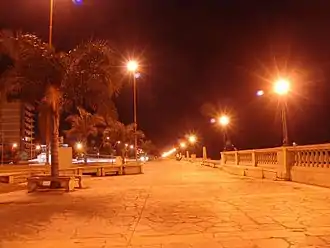

There is infrastructure for tourism that has been developed: river side bars and nightclubs, chic restaurants, the improvement of the major highways and a subfluvial tunnel.
Transport
Railway
Despite having had four railway stations, nowadays the city Santa Fe is not served by rail transport. The Mitre Railway station is no longer used since 2007, when defunct company Trenes de Buenos Aires cancelled its services to Santa Fe. Likewise, the Santa Fe Belgrano (built in 1891 and named Cultural Heritage) and Guadalupe stations had been entered into disuse in 1993 when the railway privatisation in Argentina ceased all the long-distance services in the country.
In the 2010s, the local municipality remodelled both stations as Guadalupe would be terminus for a new urban train.[7][8] Nevertheless, the original project was not carried out. On the other hand, the Santa Fe Belgrano station was re-opened as a convention center.[9]
The fourth station (also the oldest of all) had been built by French company Province of Santa Fe Railway in 1885. It was demolished in 1962 and replaced by a bus station.[10]
Railway stations in the city of Santa Fe are:
| Name | Former company | Line | Status (passenger) |
|---|---|---|---|
| Santa Fe (Mitre) | BA & Rosario | Mitre | Closed (2007) 1 |
| Santa Fe (Belgrano) | Central Northern | Belgrano | Closed (1993) 2 |
| Guadalupe | Central Northern | Belgrano | Closed (1993) 3 |
| Central Station | Prov. Santa Fe | Belgrano | Demolished (1962) 4 |
Notes:
- 1 No longer active since TBA cancelled its services.
- 2 Granted in concession to the Municipality of Santa Fe that remodelled it completely. The station re-opened as a convention center.
- 3 Refurbished in 2011 by the Municipality to be terminus of an urban train.[8] Nevertheless, the project was not carried out.
- 4 Also known as "La Francesa", it was demolished in 1962 to build a bus station.
Sports
Santa Fe put itself on the international sports map as one of the host cities of the 1990 FIBA World Championship.[11] The games were played in the Estadio de la Facultad Regional Santa Fe. The Estadio Ángel Malvicino was one of the venues of the 2002 FIVB Men's Volleyball World Championship. Santa Fe also hosted the first ever Five-pin billiards World Championship in 1965.
The city is also home to two first division football teams: Club Atlético Colón and Club Atlético Unión, who contest the Santa Fe derby. Santa Fe was also the place where the world known Amílcar Brusa was born and raised, and the home of boxers Carlos Baldomir and Julio César Vásquez.
Notable natives

- Estanislao López, past Governor
- Carlos Thompson, actor
- Diego Bustos, journalist
- Norman Briski, actor and director
- Marcos Mundstock, actor and humorist
- Ariel Ramírez, musician and composer
- Ricardo Supisiche, artist
- Reine Flachot, cellist
- Liliana Bodoc, writer
- Osvaldo Bayer, writer
- Sergio Rubin, journalist
- Francisco Urondo, poet, writer and playwright
- Fernando Birri, film maker
- Carlos Baldomir, boxer
- Julio César Vásquez, boxer
- Carlos Delfino, basketball player
- Tayavek Gallizzi, basketball player
- Carlos Guastavino, pianist, composer
- Luciano De Cecco, volleyball player
- Victoria Mayer, volleyball player
- Germán Chiaraviglio, pole vaulter
- Arturo Kenny, polo player
- Rubén Rézola, sprint canoeist
- Santiago Grassi, swimmer
- Amelia Fournel, sport shooter
- Mario Schujovitzky, football player
- Enrique García, football player
- René Pontoni, football player
- Leopoldo Luque, football player
- Pedro Pablo Pasculli, football player
- Sebastián Battaglia, football player
- Juan Antonio Pizzi, football player, manager
- Carlos Reutemann, formula one driver and governor
- Spreen, number one streamer by Argentina and top international
- Cris Huja, writer and filmmaker
- Alberto Armando, businessman and football manager
- Jorge Faurie, Diplomat, Minister of Foreign Affairs
- Rogelio Pfirter, Diplomat
Gallery
 (From top to bottom; from left to right) Panoramic view of the city; Municipal Theatre; Plaza Las Tres Culturas; Puente Colgante at night and the National University of the Littoral.
(From top to bottom; from left to right) Panoramic view of the city; Municipal Theatre; Plaza Las Tres Culturas; Puente Colgante at night and the National University of the Littoral..jpg.webp) Santa Fe, Argentina
Santa Fe, Argentina Santa Fe, Argentina
Santa Fe, Argentina Santa Fe at night
Santa Fe at night Santa Fe
Santa Fe Santa Fe from afar
Santa Fe from afar Santa Fe Cathedral
Santa Fe Cathedral Santa Fe, Argentina
Santa Fe, Argentina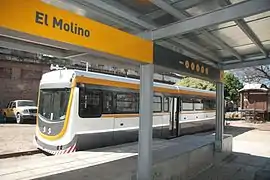
Sister cities
Santa Fe is twinned with:
 Santa Fe Springs, United States (1960)[12]
Santa Fe Springs, United States (1960)[12]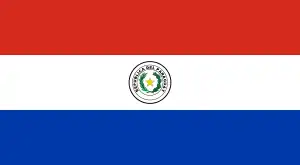 Ypacaraí, Paraguay (1978)[12]
Ypacaraí, Paraguay (1978)[12] Cuneo, Italy[12]
Cuneo, Italy[12] Montevideo, Uruguay[12]
Montevideo, Uruguay[12]
See also
- Category:People from Santa Fe, Argentina
- Paraná River steamers
- Argentine Littoral
References
- ↑ The South American Republics, page 22 - "[...] it was not until 1573 that the Spaniards from Asuncion succeeded in founding a city south of the confluence of the Paraná and Paraguay. Santa Fé was the first Spanish settlement on the Plate in territory now a part of the Argentine Republic. [...] The man who led the creoles to the pampa was Juan de Garay, a Basque, who had been one of the soldiers in the army that conquered Peru."
- ↑ "Guía Climática para el Turismo (Climate Guide for Tourists)" (in Spanish). Retrieved January 23, 2008.
- 1 2 "Clima en la Argentina: Guia Climática por Sauce Viejo Aero". Caracterización: Estadísticas de largo plazo (in Spanish). Servicio Meteorológico Nacional. Retrieved 11 April 2023.
- ↑ "Estadísticas Climatológicas Normales - período 1991-2020" (in Spanish). Servicio Meteorológico Nacional. Retrieved 11 April 2023.
- ↑ "Estadísticas Climatológicas Normales – período 1991–2020" (PDF) (in Spanish). Servicio Meteorológico Nacional. 2023. Archived from the original on 8 July 2023. Retrieved 1 August 2023.
- ↑ "Datos bioclimáticos de 173 localidades argentinas". Atlas Bioclimáticos (in Spanish). Universidad Nacional de La Plata. Retrieved June 15, 2015.
- ↑ "Acondicionan la Estación Guadalupe, en Santa Fe, con vistas al proyecto de tren urbano", El Litoral, 2010
- 1 2 "Puesta en valor de la Estación Guadalupe", El Santafesino, 18 Mar 2011
- ↑ "Estación Belgrano" on Government of Santa Fe website
- ↑ "Ferrocarril en Santa Fe"
- ↑ 1990 World Championship for Men, Archive.FIBA.com, Retrieved 18 March 2016.
- 1 2 3 4 "Asuntos Federales y Electorales". www.cancilleria.gov.ar. Archived from the original on 27 May 2012. Retrieved 12 January 2022.
External links
- Official website of Santa Fe Municipality (in Spanish)
- Santa Fe, Argentina at Curlie
 Santa Fe, Argentina travel guide from Wikivoyage
Santa Fe, Argentina travel guide from Wikivoyage